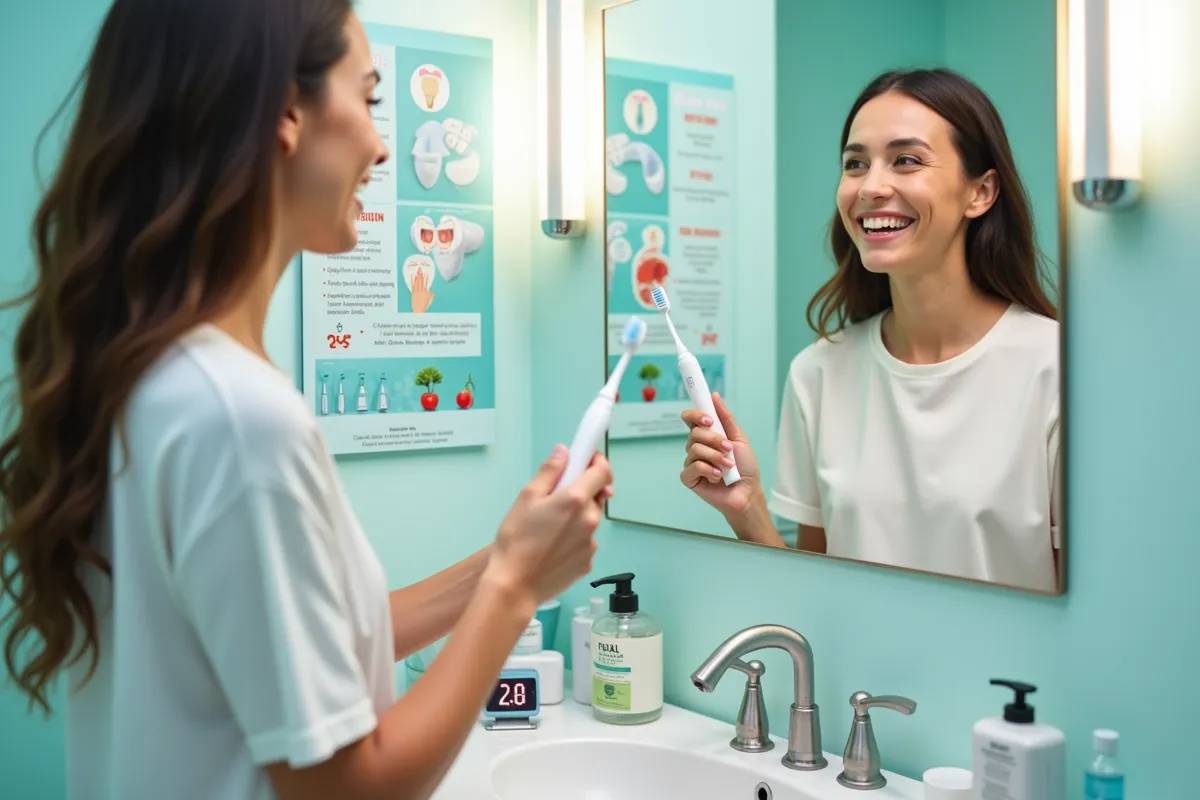Did you know that nearly half of Americans have gum disease, and poor brushing habits are often to blame? It’s a startling statistic, but it highlights just how crucial a proper oral hygiene routine is for our overall health. From preventing cavities to keeping our hearts healthy, good brushing habits play a pivotal role in our well-being.
In this article, we’re diving into the essentials of brushing like a pro. We’ll cover expert tips to elevate your oral care game, ensuring your teeth and gums stay in top shape. Whether you’re curious about the right brushing technique, the best tools for the job, or the frequency that gets the best results, we’ve got you covered. So, grab your toothbrush, and let’s conquer that oral hygiene routine together!
Feel free to drop your thoughts or questions in the comments as we embark on this journey to a healthier smile.
Choose the Right Tools
Mastering oral hygiene starts with selecting the right tools. Here’s a deeper dive into how to equip yourself for a top-notch dental care routine:
Toothbrush Selection
- Soft Bristles: Gentle on gums and effective at plaque removal. Soft bristles are less likely to cause gum recession or enamel wear compared to harder bristles.
Electric vs. Manual:
- Electric: Offers superior cleaning with oscillating or vibrating heads, often removing more plaque. Ideal for those with limited manual dexterity or who prefer a tech-assisted clean.
- Manual: Effective when used correctly, and offers a cost-effective, convenient option. Ensure you’re brushing for two minutes, twice daily.
Toothpaste Matters
- Fluoride Importance: Essential for strengthening enamel and preventing cavities. Always opt for toothpaste containing fluoride.
Personal Needs:
- Sensitivity: Choose toothpaste specifically designed to reduce sensitivity, helping to ease discomfort.
- Whitening: Opt for formulas that aim to brighten your smile with additional stain-fighting agents.
Additional Tools
- Interdental Brushes: Reach areas a regular toothbrush can’t, essential for cleaning between teeth and preventing plaque buildup in tight spaces.
- Tongue Scrapers: Help remove bacteria from the tongue’s surface, reducing bad breath and enhancing overall mouth cleanliness.
- Mouthwash: Complements brushing and flossing by rinsing away debris and providing an extra layer of protection against bacteria. Great for freshening breath as well.
Selecting the right tools tailored to your needs ensures a comprehensive approach to oral hygiene, setting you on the path to a healthier smile. What tools do you swear by in your routine? Feel free to share your experiences or ask questions in the comments below!
Master the Proper Brushing Technique
Perfecting your brushing technique is key to maintaining excellent oral health. Here’s a detailed guide to help you brush like a pro:
Timing and Frequency
- Ideal Time: Brush for at least 2 minutes to ensure every tooth gets the attention it needs.
- Recommended Frequency: Brush twice daily, once in the morning and once before bed, to effectively remove plaque and prevent decay.
Step-by-Step Brushing
- Angle and Grip: Hold your toothbrush at a 45-degree angle to your gums. This positioning helps clean the gum line where plaque can build up.
- Motion: Use gentle circular motions rather than back-and-forth scrubbing. This technique helps protect your gums and ensures thorough cleaning.
- Coverage: Make sure to clean all surfaces of your teeth—outer, inner, and chewing surfaces. Don’t rush; give each section the time it deserves.
Common Mistakes
- Brushing Too Hard: Applying excessive pressure can lead to gum recession and enamel wear. Use a light touch; imagine you’re massaging your teeth rather than scrubbing them.
- Neglecting Back Teeth: It’s easy to overlook the molars, but these teeth are crucial for chewing and are prone to plaque buildup. Spend extra time reaching those tricky areas.
- Skipping Tongue Brushing: Your tongue can harbor bacteria that cause bad breath. Gently brush your tongue or use a tongue scraper for a fresher mouth.
By mastering these techniques, you’ll not only enhance your oral hygiene but also contribute to your overall health. How do you ensure you’re brushing correctly? Join the conversation in the comments below and share your tips or questions!
Don’t Forget to Floss
Flossing is a crucial step in your oral hygiene routine, helping you maintain a healthy smile by reaching places your toothbrush can’t.
Importance of Flossing
- Complement to Brushing: While brushing cleans the surfaces of your teeth, flossing tackles the spaces between them, removing plaque and debris that can lead to cavities and gum disease.
- Gum Health: Regular flossing helps prevent gum inflammation and bleeding, contributing to overall oral health.
Proper Flossing Technique
- Length of Floss: Start with about 18 inches of floss, winding most around one finger on each hand, leaving about 1-2 inches to work with.
- Gentle Motion: Slide the floss gently between your teeth. Avoid snapping it against your gums.
- C Shape: Curve the floss around each tooth in a C shape, moving it up and down to clean the sides of the teeth and beneath the gum line.
- Use Fresh Sections: As you move from tooth to tooth, unroll a fresh section of floss to ensure you’re not reinserting plaque you’ve already removed.
Alternative Tools
- Floss Picks: Handy and easy to use, especially for those with limited dexterity. They offer a convenient way to floss on the go.
- Water Flossers: Ideal for those who find traditional flossing difficult or have braces. They use a stream of pulsating water to remove food particles and plaque between teeth and along the gum line.
- Interdental Brushes: Perfect for those with wider gaps between their teeth, offering an effective alternative for cleaning hard-to-reach areas.
Incorporating flossing into your daily routine is a small step that can make a big difference in your oral health. What methods do you prefer for flossing? Share your tips or ask questions in the comments below!
Incorporate Mouthwash into Your Routine
Adding mouthwash to your oral hygiene routine is like giving your mouth an extra layer of protection and care. Here’s how this simple step can enhance your dental health:
Benefits
- Bacteria Reduction: Mouthwash helps eliminate bacteria that brushing and flossing might miss, reducing the risk of cavities and gum disease.
- Fresh Breath: Provides a quick and effective way to freshen breath, neutralizing odors for a confidence boost throughout the day.
- Gum Disease Prevention: Regular use can help prevent gingivitis by reducing plaque buildup and inflammation.
Choosing the Right Mouthwash
- Antibacterial: Ideal for those prone to plaque and gingivitis, as it targets harmful bacteria.
- Fluoride: Strengthens tooth enamel and protects against cavities, perfect for those looking to enhance their cavity protection regime.
- Alcohol-Free: Suitable for those with sensitive mouths or who prefer a gentler option, without the burn of traditional mouthwashes.
Proper Use
- Measure Correctly: Pour the recommended amount into a cup. Most mouthwashes suggest 20 milliliters (about 4 teaspoons).
- Swish Thoroughly: Swish the mouthwash around your mouth vigorously for 30 seconds to 1 minute. Be sure to cover all areas, including teeth and gums.
- Avoid Rinsing Immediately: For maximum effectiveness, avoid drinking water or rinsing your mouth for at least 30 minutes after use to allow the beneficial ingredients to work.
Incorporating mouthwash into your routine is an easy yet impactful way to boost your oral hygiene. Which type of mouthwash do you find most effective? Join the discussion in the comments below and share your experiences or ask questions!
Adopt a Holistic Approach to Oral Health
Achieving optimal oral health goes beyond brushing and flossing—it’s about embracing a holistic lifestyle that supports your smile from the inside out. Here’s how to ensure your oral health thrives:
Diet and Hydration
- Nutrient-Rich Foods: Fuel your body with fresh fruits, vegetables, lean proteins, and whole grains. These foods supply essential nutrients that support strong teeth and healthy gums.
- Hydrate Frequently: Drinking plenty of water helps wash away food particles and bacteria, as well as maintains a clean mouth. It also stimulates saliva production, which is crucial in neutralizing acids and protecting tooth enamel.
Regular Dental Checkups
- Routine Visits: Schedule dental checkups every six months. Regular cleanings and assessments allow your dentist to catch potential issues early, preventing more significant problems.
- Professional Advice: Use these visits to seek personalized advice on your oral health habits and product recommendations tailored to your needs.
Lifestyle Habits
- Smoking Cessation: Smoking can lead to gum disease, tooth discoloration, and even oral cancer. Quitting smoking not only benefits your oral health but also improves your overall well-being.
- Manage Sugar Intake: Excessive sugar consumption can lead to tooth decay. Opt for natural sweeteners and limit sugary snacks and drinks. If you indulge, rinse your mouth with water or brush your teeth afterward to minimize harm.
Adopting a holistic approach ensures that your oral health is comprehensive and well-rounded, contributing to a healthier life overall. What changes have you made to enhance your oral health? Share your thoughts or questions in the comments below!
Tips for Kids and Special Needs
Caring for young smiles and those with special orthodontic needs requires a unique approach. Here’s how to tailor oral hygiene practices for these groups:
Brushing for Kids
- Make It Fun: Turn brushing into an engaging activity by using toothbrushes with fun designs or favorite characters. Singing a two-minute song or using a timer can make the process enjoyable and ensure proper brushing duration.
- Teach Techniques Early: Demonstrate the correct way to brush, encouraging gentle circular motions and covering all tooth surfaces. Use a mirror so kids can watch and learn.
- Reward System: Implement a reward chart to encourage consistent brushing habits. Small stickers or rewards for brushing twice a day can motivate kids to maintain their routines.
Oral Hygiene for Braces
- Specialized Tools: Use tools like interdental brushes, floss threaders, and water flossers to clean around braces and wires. These tools can reach areas that regular toothbrushes might miss.
- Fluoride Toothpaste: Opt for fluoride toothpaste to strengthen enamel and protect against cavities, which are common around brackets.
- Regular Checkups: Schedule frequent dental visits for professional cleanings and to ensure braces are well-maintained. Dentists can offer additional tips for keeping teeth clean and healthy during orthodontic treatment.
By adapting these strategies, you can help kids and individuals with braces maintain excellent oral hygiene. What tips have worked for you or your family? Feel free to share your experiences or ask questions in the comments below!
Conclusion
Wrapping up our journey to healthier smiles, here’s a quick recap of the essential steps to elevate your oral hygiene routine:
- Master the Basics: Remember the importance of brushing for at least two minutes, twice daily, using proper techniques to cover all tooth surfaces.
- Floss Regularly: Complement brushing by flossing to remove plaque and debris between teeth, ensuring a comprehensive clean.
- Add Mouthwash: Incorporate mouthwash to reduce bacteria, freshen breath, and protect against gum disease, choosing the right type for your needs.
- Holistic Approach: Support your oral health with a balanced diet, adequate hydration, regular dental checkups, and managing lifestyle habits like smoking and sugar intake.
- Tailored Tips for Kids and Braces: Use engaging methods to teach kids proper brushing, and employ specialized tools for individuals with braces to maintain cleanliness.
- Encourage Consistency: The secret to lasting dental health lies in maintaining a consistent routine. Integrate these practices into your daily life to enjoy a radiant, healthy smile for years to come.
Consistency is key—embrace these habits and make them a natural part of your day. How do you keep up with your oral hygiene routine? Join the conversation below and share your strategies or ask any lingering questions!
We’d love to hear from you! What are your go-to oral hygiene tips that keep your smile shining bright? Share your favorites in the comments below and let’s spark a lively discussion. Whether you’ve got a unique brushing technique or a secret to fresh breath, your insights could be just what someone else needs. Join our friendly community, ask questions, and exchange ideas—together, we can all achieve healthier, happier smiles!
Frequently Asked Questions about Oral Hygiene
1. What is the best technique for brushing my teeth?
- Use a soft-bristled toothbrush and fluoride toothpaste. Hold the brush at a 45-degree angle to your gums and use gentle circular motions to clean all surfaces of your teeth. Don’t forget to brush your tongue to remove bacteria and freshen your breath.
2. How important is flossing, really?
- Flossing is crucial for removing plaque and food particles between teeth where a toothbrush can’t reach. It helps prevent cavities and gum disease, so make it a daily habit.
3. How often should I visit the dentist?
- It’s recommended to visit the dentist every six months for routine checkups and cleanings. However, your dentist may suggest more frequent visits if you have specific oral health issues.
4. How can I maintain oral health if I have braces?
- Use specialized tools like interdental brushes and floss threaders to clean around brackets and wires. Regular dental checkups and using fluoride toothpaste can also help maintain oral health during orthodontic treatment.
5. Does diet affect oral hygiene?
- Absolutely! A diet high in sugar can lead to cavities, while a balanced diet rich in fruits, vegetables, and whole grains supports overall oral health. Staying hydrated helps maintain saliva production, which is essential for neutralizing acids in the mouth.
6. Is mouthwash necessary in my oral hygiene routine?
- While not essential, mouthwash can be a beneficial addition. It helps reduce bacteria, freshens breath, and can strengthen teeth if it contains fluoride. Choose a mouthwash that suits your specific needs, such as alcohol-free options for sensitive mouths.
7. What are some tips for teaching kids to brush properly?
- Make brushing fun with toothbrushes that have favorite characters, use a timer or a song to ensure they brush for two minutes, and demonstrate the technique using a mirror to guide them.
Feel free to ask more questions or share your own tips for maintaining a healthy smile in the comments section!





















